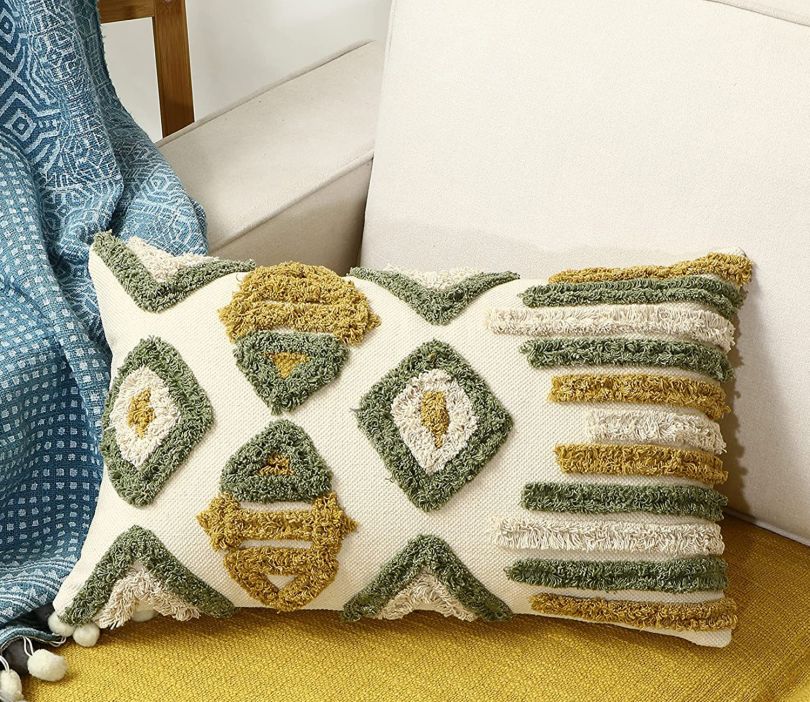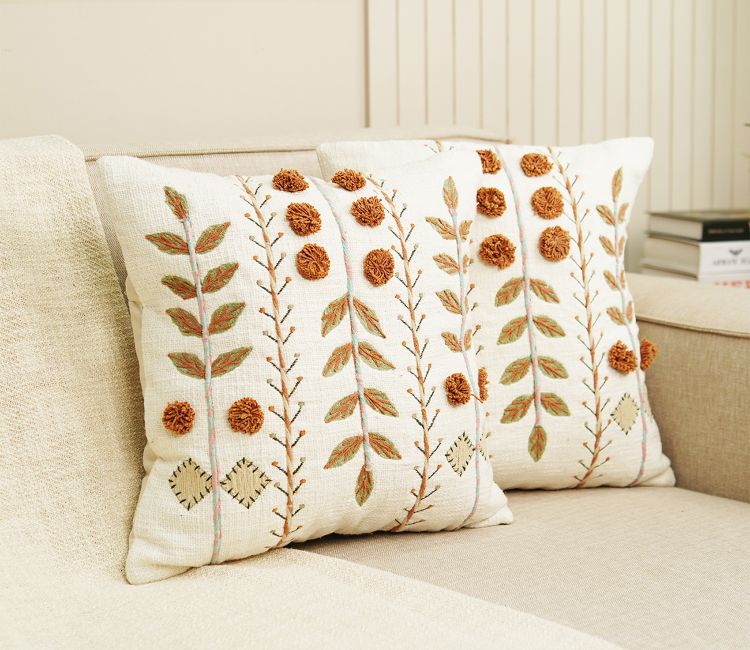Cushion covers are a simple yet transformative addition to any home, bringing style, comfort, and personality to your living space. Whether you’re refreshing your sofa or adding flair to your bedroom, choosing the right fabric for your cushion cover is key to achieving the perfect balance of aesthetics, durability, and functionality. With countless options available, from luxurious silks to sturdy cottons, selecting the ideal material can feel overwhelming. In this article, we’ll explore the best fabrics for cushion cover designs, focusing on their unique qualities, benefits, and suitability for different spaces, including cushion covers for sofas.

Why Fabric Choice Matters for Cushion Covers
The fabric of a cushion cover determines not only its look and feel but also its longevity and maintenance needs. A well-chosen fabric can elevate your cushion cover design, complementing your home decor while withstanding daily wear and tear. Factors like texture, durability, ease of cleaning, and aesthetic appeal play a significant role in making the right choice. Let’s dive into the top fabrics for cushion covers and why they stand out.
1. Cotton: The Versatile Classic
Cotton is a timeless favorite for cushion covers, known for its versatility, affordability, and comfort. This natural fiber is soft to the touch, breathable, and available in a wide range of patterns and colors, making it ideal for any cushion cover design.
Benefits of Cotton Cushion Covers
- Durability: Cotton is strong and can handle regular use, especially in high-traffic areas like living rooms.
- Breathability: It keeps cushions cool and comfortable, perfect for warm climates.
- Easy Maintenance: Most cotton covers are machine-washable, making them a practical choice for homes with kids or pets.
- Variety: From vibrant prints to minimalist solids, cotton offers endless design possibilities for cushion covers for sofas.
Best Use
Cotton is perfect for everyday use in casual settings. It works beautifully for cushion cover designs that need to blend functionality with style, such as in cozy living rooms or family-friendly spaces.
Considerations
Lower-quality cotton may pill or fade over time, so opt for high-thread-count options for better durability.
2. Linen: Rustic Elegance
Linen is another natural fabric that exudes understated elegance, making it a popular choice for cushion covers. Its slightly textured surface adds a touch of sophistication to any space.
Benefits of Linen Cushion Covers
- Aesthetic Appeal: Linen’s natural sheen and texture create a chic, rustic look, ideal for modern and bohemian interiors.
- Durability: Linen is tough and gets softer with each wash, ensuring long-lasting cushion covers.
- Eco-Friendly: Made from flax, linen is sustainable and biodegradable.
- Breathability: Like cotton, linen is highly breathable, keeping your cushions fresh.
Best Use
Linen cushion covers for sofas are perfect for creating a relaxed yet refined vibe in living rooms or outdoor patios. Pair them with neutral tones or bold accents for a versatile look.
Considerations
Linen wrinkles easily, which may not suit those seeking a pristine appearance. It’s also slightly more expensive than cotton.
3. Silk: Luxurious Indulgence
For those seeking a touch of luxury, silk is an excellent choice for cushion cover designs. Its smooth, glossy surface adds a sense of opulence to any space.
Benefits of Silk Cushion Covers
- Luxurious Feel: Silk’s soft and smooth texture feels indulgent, making it perfect for formal settings.
- Vibrant Colors: Silk holds dyes well, resulting in rich, vibrant hues that elevate cushion covers.
- Hypoallergenic: Naturally resistant to dust mites, silk is a great choice for allergy sufferers.
Best Use
Silk cushion covers are best suited for low-traffic areas like formal living rooms, master bedrooms, or decorative seating arrangements. They’re ideal for special occasions or when you want to impress guests.
Considerations
Silk requires delicate care, often needing dry cleaning or hand washing. It’s also less durable than cotton or linen, so it’s not ideal for heavy use.
4. Velvet: Plush and Trendy
Velvet has made a strong comeback in home decor, and its plush texture makes it a standout choice for cushion covers for sofas. This fabric adds a cozy yet glamorous touch to any space.
Benefits of Velvet Cushion Covers
- Rich Texture: Velvet’s soft, plush surface creates a warm and inviting feel.
- Color Depth: It reflects light beautifully, giving colors a deep, luxurious appearance.
- Durability: Modern synthetic velvets, like polyester blends, are more resistant to wear and stains than natural velvet.
Best Use
Velvet cushion cover designs are perfect for adding drama to contemporary or eclectic interiors. They work well in cozy winter setups or as statement pieces in minimalist spaces.
Considerations
Velvet can attract dust and pet hair, so regular maintenance is necessary. Synthetic velvet is often more practical than natural velvet for everyday use.
5. Polyester: Budget-Friendly and Durable
Polyester is a synthetic fabric that offers a cost-effective and durable option for cushion covers. It’s often blended with other materials to enhance its qualities.
Benefits of Polyester Cushion Covers
- Affordability: Polyester is budget-friendly, making it accessible for those looking to update their decor without breaking the bank.
- Durability: It resists fading, stretching, and wrinkling, ensuring long-lasting cushion covers.
- Stain Resistance: Polyester is easy to clean and often treated to repel stains, making it ideal for busy households.
Best Use
Polyester cushion covers for sofas are great for high-traffic areas like family rooms or homes with young children. They’re also suitable for outdoor cushions when treated for weather resistance.
Considerations
Polyester may not feel as luxurious as natural fabrics and can be less breathable, so it’s best for practical rather than decorative purposes.
6. Wool: Cozy and Timeless
Wool is a warm, durable, and slightly textured fabric that’s perfect for cushion cover designs in colder climates.
Benefits of Wool Cushion Covers
- Warmth: Wool’s insulating properties make it ideal for cozy, winter-friendly decor.
- Durability: It’s naturally resilient and can withstand heavy use.
- Texture: Wool adds a tactile quality, enhancing the visual appeal of cushion covers.
Best Use
Wool cushion covers are excellent for creating a snug atmosphere in living rooms or bedrooms during colder months. They pair well with rustic or Scandinavian-inspired decor.
Considerations
Wool can be prone to pilling and may require professional cleaning. It’s also more expensive than cotton or polyester.
Tips for Choosing the Right Fabric
When selecting a fabric for your cushion cover, consider the following:
- Purpose: Will the cushion be decorative or functional? For heavy use, choose durable fabrics like cotton or polyester. For decorative pieces, silk or velvet works well.
- Location: Outdoor cushions need weather-resistant fabrics like treated polyester, while indoor cushions can use softer materials like linen or silk.
- Maintenance: If you prefer low-maintenance options, opt for machine-washable fabrics like cotton or polyester.
- Style: Match the fabric to your decor. For example, linen suits bohemian vibes, while silk complements formal settings.

Conclusion
Choosing the right fabric for your cushion cover is a balance of style, comfort, and practicality. Cotton and polyester offer versatility and durability for everyday use, while linen and wool bring texture and warmth. For a touch of luxury, silk and velvet are unbeatable. By understanding the unique qualities of each fabric, you can select the perfect cushion cover design to enhance your home’s aesthetic and functionality. Explore Wooden Street’s collection of cushion covers for sofas to find the ideal fabric and design to elevate your living space.
















